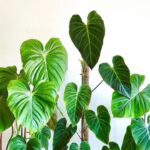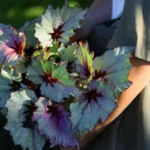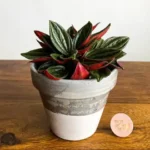Understanding Sinningia leucotricha: A Unique Tuberous Houseplant
Sinningia leucotricha, commonly known as Brazilian Edelweiss, is a fascinating and charming plant that has attracted the attention of indoor plant enthusiasts and collectors around the world. Native to the rocky hills of southeastern Brazil, this tuberous perennial belongs to the Gesneriaceae family. With its velvety silver leaves and caudex (a swollen stem or root), it presents both an exotic appearance and an unusual growth habit that make it a standout specimen for any indoor plant collection.
What makes Sinningia leucotricha particularly intriguing is its deciduous habit: it goes dormant during certain times of the year, shedding its leaves but preserving energy within its tuber. This behavior can be puzzling for plant novices but is easy to manage once you understand its natural cycle.
Key Identifying Features
Even among unusual houseplants, Sinningia leucotricha is remarkably distinctive. Here are some of its key characteristics:
- Leaves: Silvery, felt-like foliage with a soft texture; typically produced in a rosette at the top of the caudex.
- Caudex: A thick, rounded stem base that functions as a water and nutrient reservoir.
- Flowers: Tubular, slightly nodding orange to reddish blooms that emerge in spring.
- Size: Generally stays compact, with a caudex growing up to 4–6 inches in diameter and the plant reaching 6–12 inches tall.
Lighting and Placement
To keep your Sinningia leucotricha happy, providing the right lighting conditions is essential. In its native habitat, this plant grows among rocks and receives filtered light. Mimic this in your home for healthy growth.
- Ideal Light: Bright, indirect light. An east-facing window is perfect, giving it morning sun without the harsh intensity of afternoon rays.
- Avoid: Direct, intense sunlight, especially during summer, which can scorch its leaves.
- Supplemental Lighting: In low-light environments, a grow light can help maintain strong growth, particularly during the active growing season.
Watering and Dormancy Cycle
Understanding Sinningia leucotricha’s dormancy cycle is key to successful care. This is a plant that changes its needs throughout the year.
During Active Growth (Spring through Summer)
- Water regularly: Keep the soil lightly moist but not soggy. Allow the top inch of soil to dry between waterings.
- Reduce overwatering risk: The caudex stores water, so err on the side of underwatering rather than excess moisture to prevent rot.
During Dormancy (Fall and Winter)
- Leaf drop is normal: The plant will shed its leaves and rest; don’t panic—it’s part of the cycle.
- Greatly reduce watering: Water very sparingly, about once a month, just enough to keep the caudex from shriveling.
Tip: Resume regular watering only when new growth starts to emerge in the spring.
Soil and Potting Tips
Good drainage is non-negotiable for this plant. Since its caudex is particularly susceptible to rot, it’s critical to avoid waterlogged conditions.
- Soil mix: A well-draining cactus or succulent mix works well. You can also create your own mix using:
- 1 part potting soil
- 1 part perlite or pumice
- 1 part coarse sand
- Pot choice: Use a shallow pot with ample drainage holes. Terracotta pots are especially helpful since they allow excess moisture to evaporate easily.
- Repotting: Every 2–3 years during early spring is ideal, just as new growth begins.
Temperature and Humidity
Sinningia leucotricha appreciates a warm, stable environment but doesn’t require high humidity like many tropical plants. Its ideal conditions include:
- Temperature range: 65°F to 80°F (18°C to 27°C) during the growing season.
- Avoid cold temperatures: Below 50°F (10°C) can damage the caudex or hamper future growth.
- Humidity: Moderate indoor levels are sufficient (40–50%). Avoid misting the leaves directly, as this can cause spotting or mold.
Understanding Flowering and Seasonal Behavior
Flowering is one of the most rewarding parts of growing Sinningia leucotricha. The tubular flowers bloom in early spring and are typically pollinated by hummingbirds in the wild.
To encourage blooming at home:
- Ensure the plant gets enough light during the active season.
- Use a diluted, balanced fertilizer (like 10-10-10) every 4–6 weeks during growth.
- Avoid fertilizing during dormancy.
The plant’s dormancy might lead newcomers to think it has died, especially when it sheds all its leaves. However, as long as the caudex remains firm and healthy, it will spring back to life in a few months.
Pests and Common Issues
Sinningia leucotricha is not especially pest-prone, but like all houseplants, it can occasionally suffer issues. The most common concerns include:
- Mealybugs: Look for cottony white masses. Remove manually with rubbing alcohol on a cotton swab.
- Spider mites: Often found in dry conditions. Increase humidity slightly and spray with insecticidal soap if needed.
- Rot: Usually linked to overwatering. Always let soil dry partially between waterings.
Propagation and Growth from Seed
While Sinningia leucotricha can be propagated via seed, it’s not the quickest route. Seeds germinate in warm, moist conditions and take several months to form noticeable tubers. Most home growers prefer to purchase established plants, but if you’re adventurous:
- Start seeds in spring: Use a seed-starting mix in a shallow tray.
- Keep moist and warm: Ideal temperature is around 75°F (24°C).
- Provide bright indirect light: Too little light slows down seedling development.
Bringing It All Together
Sinningia leucotricha offers indoor gardeners a unique plant experience that differs from the typical leafy tropicals. With its distinctive silver foliage, thick caudex, and fascinating seasonal cycle, it provides both beauty and learning opportunities for those interested in expanding their houseplant horizons. Though it may seem mysterious at first, with patience and the right care, this Brazilian gem will reward you with cycles of growth and bloom for years to come.
Whether you’re a seasoned collector or new to the plant world, Sinningia leucotricha is a low-stress, high-interest species that invites you into the fascinating world of caudiciform plants—offering beauty, botanical intrigue, and something to look forward to every spring.
References
- Clark, J.L., & Zimmer, E.A. (2003). A molecular phylogeny of the Gesneriaceae and implications for the evolution of floral morphology. American Journal of Botany, 90(2), 301–314.
- Royal Horticultural Society. (2022). Sinningia leucotricha – cultivation notes. Retrieved from https://www.rhs.org.uk
- Smith, D. (2015). Tuberous Gesneriads: Rare Jewels for the Enthusiastic Grower. The Gesneriad Society Journal, 65(4), 122–129.








